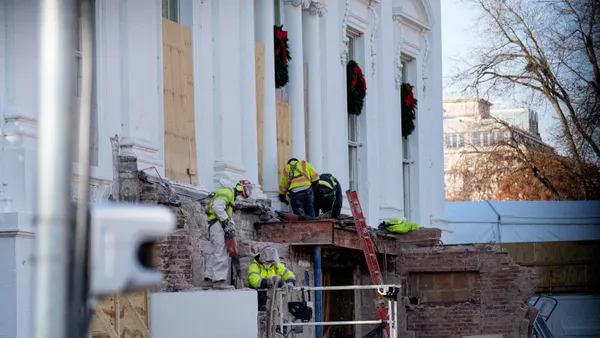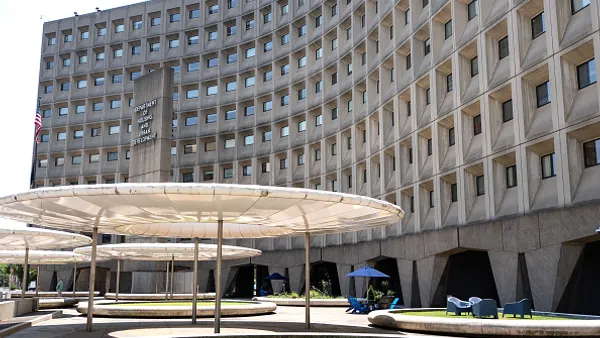UPDATE: Dec. 10, 2019: The New York City Council on Tuesday passed the new regulation requiring bird-friendly material on new construction and major alteration projects by an overwhelming majority.
In a joint statement with the New York City Audubon and other groups, Benjamin Prosky, the executive director of the American Institute of Architects New York Chapter, said, "The materials and techniques that prevent bird collisions are already commonly used for a variety of reasons in our buildings; this legislation mandates their use in ways that also protect birds in cost effective ways, AIANY and its members are proud to have fought for this commonsense bill."
Dive Brief:
- The New York City Council is expected to pass legislation Tuesday designed to prevent bird strikes that will apply to all new construction projects. The council's Committee on Housing and Buildings passed the regulation by unanimous vote Monday.
- The new rule would require that 90% of the external building envelope for the first 75 feet of new construction and major alterations be made of bird-safe materials, including glass treated with ceramic frits, etchings or frosted patterns, all of which can make glass appear as an obstacle to birds but still provide transparency for humans.
- The rule would also require that bird-friendly materials be installed on the entirety of the first 12 feet of a building’s exterior walls that are adjacent to a green roof system, on the entirety of the first 75 feet of fly-through conditions and on the entirety of bird-hazard installations — glass awnings, handrails, windbreak panels and acoustic barriers — no matter the height.
Dive Insight:
The law would go into effect for construction document approval applications filed starting one year from the passage of the legislation.
The bill also specifies that any bird-safe material must comply with a specified “threat factor” based on American Bird Conservancy protocols but may also comply with a relevant ASTM standard.
New York City is positioned on the Atlantic Flyway, according to the New York City Audubon, and traveled by hundreds of thousands of birds each year. Of the 100 million birds killed annually in the U.S. as a result of collisions with buildings — a conservative estimate — 90,000 to 230,000 of those deaths take place in New York City.
The New York City bill, said Andrew Maas, communications manager at NYC Audubon, is one of the most bird-friendly regulations to be proposed. "We definitely hope that other cities will follow [New York City's] lead and enact similar legislation," he said.
The proposal, Maas said, garnered a great deal of support from the city's birding community, which is evidenced by its 21-strong list of sponsors. Maas added that bird advocates made a point of working with local real estate and development communities to address their concerns about how bird-safety regulations would affect them.
Minnesota bird advocates are likely hoping that U.S. Bank Stadium officials will take a similar bird-safety view when considering the results of a two-year Minnesota Sports Facilities Authority (MSFA) study of bird collisions at the home of the Minnesota Vikings.
At a recent MSFA meeting, according to the Star Tribune, the authority reported that approximately 111 migrating songbirds are killed each year after flying into the stadium's 200,000 square feet of glass. The reflection of the untreated glass appears to birds as trees and open sky. Minnesota Audubon officials said at the MSFA meeting that retrofitting the glass with an appropriate film could reduce collisions by between 80% and 85%.
The estimated cost of a retrofit ranges from $40,000 to $570,000 for materials alone. The study itself cost $300,000.
The MSFA, Vikings and stadium operator ASM Global are expected to review the study and decide on a solution. If they decide to move forward with the retrofit, officials do not expect to issue a Request for Proposals sooner than next summer.













